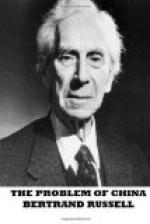Throughout Japanese politics since the Restoration, there are two separate strands, one analogous to that of Western nations, especially pre-war Germany, the other inherited from the feudal age, which is more analogous to the politics of the Scottish Highlands down to 1745. It is no part of my purpose to give a history of modern Japan; I wish only to give an outline of the forces which control events and movements in that country, with such illustrations as are necessary. There are many good books on Japanese politics; the one that I have found most informative is McLaren’s Political History of Japan during the Meiji Era 1867-1912 (Allen and Unwin, 1916). For a picture of Japan as it appeared in the early years of the Meiji era, Lafcadio Hearn is of course invaluable; his book Japan, An Interpretation shows his dawning realization of the grim sides of the Japanese character, after the cherry-blossom business has lost its novelty. I shall not have much to say about cherry-blossom; it was not flowering when I was in Japan.
Before, 1867, Japan was a feudal federation of clans, in which the Central Government was in the hands of the Shogun, who was the head of his own clan, but had by no means undisputed sway over the more powerful of the other clans. There had been various dynasties of Shoguns at various times, but since the seventeenth century the Shogunate had been in the Tokugawa clan. Throughout the Tokugawa Shogunate, except during its first few years, Japan had been closed to foreign intercourse, except for a strictly limited commerce with the Dutch. The modern era was inaugurated by two changes: first, the compulsory opening of the country to Western trade; secondly, the transference of power from the Tokugawa clan to the clans of Satsuma and Choshu, who have governed Japan ever since. It is impossible to understand Japan or its politics and possibilities without realizing the nature of the governing forces and their roots in the feudal system of the former age. I will therefore first outline these internal movements, before coming to the part which Japan has played in international affairs.
What happened, nominally, in 1867 was that the Mikado was restored to power, after having been completely eclipsed by the Shogun since the end of the twelfth century. During this long period, the Mikado seems to have been regarded by the common people with reverence as a holy personage, but he was allowed no voice in affairs, was treated with contempt by the Shogun, was sometimes deposed if he misbehaved, and was often kept in great poverty.
Of so little importance was the Imperial person in the days of early foreign intercourse that the Jesuits hardly knew of the Emperor’s existence. They seem to have thought of him as a Japanese counterpart of the Pope of Rome, except that he had no aspirations for temporal power. The Dutch writers likewise were in the habit of referring to the Shogun as “His Majesty,”




